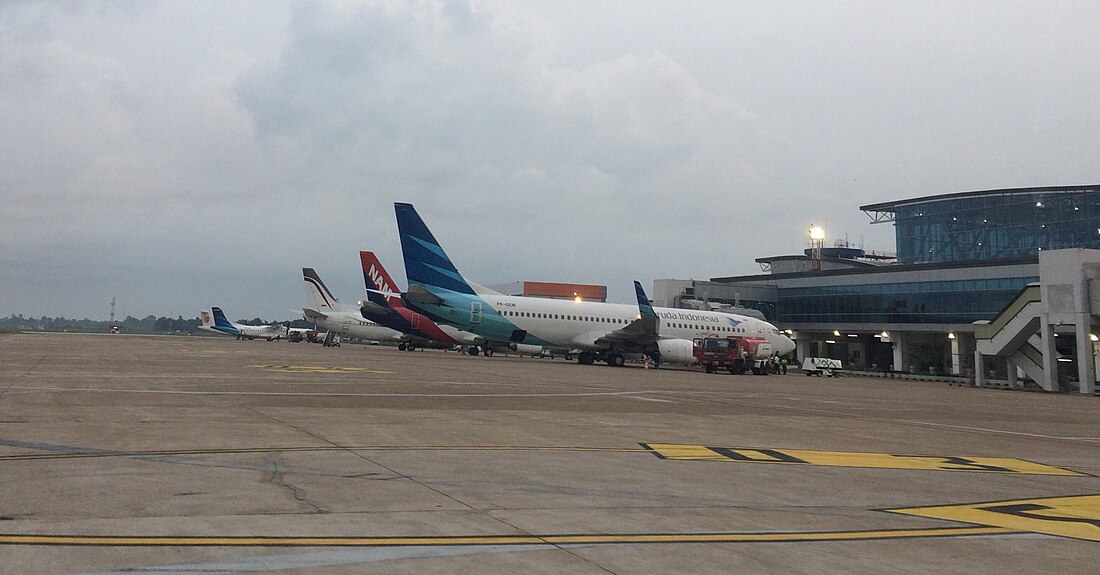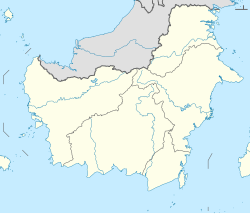Top Qs
Timeline
Chat
Perspective
Supadio International Airport
Airport serving Pontianak, West Kalimantan, Indonesia From Wikipedia, the free encyclopedia
Remove ads
Supadio International Airport (IATA: PNK, ICAO: WIOO), formerly Sei Durian Airport, is an international airport serving Pontianak, West Kalimantan, Indonesia. The airport is located in Kubu Raya Regency, about 17 kilometres (11 mi) from the center of Pontianak and serves as the main gateway to both the city and the province of West Kalimantan. The airport is named after Lieutenant Colonel Supadio, an Indonesian Air Force officer who was one of the commanding officers of the air force base located at the airport. The airport operates regular flights to major Indonesian cities such as Jakarta, Semarang, and Surabaya, as well as to other Kalimantan cities like Banjarmasin and Balikpapan. It also serves rural destinations in the interior of West Kalimantan. The airport has a several international routes, mainly Malaysia to the city of Kuching, Penang, and Kuala Lumpur.
It was named the best airport in Asia-Pacific in 2020 (2 to 5 million passengers per annum) by Airports Council International.[3]
The airport shares its facilities, including the runway, with Supadio Air Force Base, a Type-A airbase operated by the Indonesian Air Force. The base hosts two key squadrons: the 1st Air Combat Squadron, which operates a fleet of 18 Hawk 109/209 aircraft, and the 51st UAV Squadron, which operates a fleet of CAIG Wing Loong.[4] Due to its proximity to the Malaysian border and the South China Sea, Supadio Air Force Base holds significant strategic importance for national defense and regional security.
Remove ads
History
Summarize
Perspective


The airport was originally built in the early 1940s and was initially named Sei Durian Airport. Its development began after the Dutch colonial government obtained an agreement with the Pontianak Sultanate, which granted land for the construction of an airfield.[5] The Dutch conducted surveys around the Sei Durian area and ultimately selected the site for its strategic defensive value, particularly to deter a potential Japanese invasion of the Dutch East Indies. However, before construction could commence, the Dutch colonial administration surrendered to Japanese forces. During the occupation, the Japanese military government recognized the site’s strategic importance and proceeded with the construction of the airstrip. Several Japanese military aircraft were stationed at Sei Durian throughout the war.[5] However, the airbase suffered significant damage due to Allied bombing raids. After Japan’s surrender in 1945, the Dutch briefly regained control of the airstrip but made no efforts to repair the damaged facilities. The site was eventually handed over to the newly established Indonesian government, which, over the following years, gradually developed and expanded the airfield into a fully operational airport.[5]
In the early 1960s, in preparation for Operation Dwikora—part of the Indonesia–Malaysia Confrontation, a military campaign aimed at opposing the formation of Malaysia—the airbase was upgraded due to its strategic significance and proximity to the Sarawak border.[5] During the confrontation, the airbase served as a key base for operations against Commonwealth forces.
In the 1980s, the airport was renamed Supadio Airport in honor of Lieutenant Colonel Supadio, an Indonesian Air Force officer who had been stationed at the airbase. Supadio tragically died in an airplane crash alongside Colonel Nurtanio Pringgoadisurjo in Bandung in 1966.[6]
International services began in the 1970s with flights to Kuching in neighboring Sarawak, operated by Merpati Nusantara Airlines. In the 1980s, flights to Singapore were introduced by both Garuda Indonesia and Merpati. In late October 1989, Malaysia Airlines began service between Kuching and Pontianak. These international routes were suspended in 1998 during the Asian Financial Crisis.[7] However, flights to Kuching resumed in mid-1999, successively operated by Batavia Air, Kalstar Aviation, and Xpress Air, before Wings Air took over the route. In the early to mid-2010s, short-lived international routes included flights to Singapore (operated by Batavia Air) and Johor Bahru (operated by Xpress Air).[7] AirAsia also launched flights to Kuala Lumpur in late March 2015, but these services were suspended during the COVID-19 pandemic. Due to the absence of active international routes, the Ministry of Transportation officially revoked the airport’s international status on 2 April 2024.[8] Following negotiations between the West Kalimantan provincial government and the Ministry of Transportation,[9] the international status of the airport was reinstated on 4 June 2025.[10]
Remove ads
Facilities and development
Summarize
Perspective
The airport previously faced overcapacity issues, as it could only accommodate 1.5 million passengers annually. In response, a new terminal was constructed between 2015 and 2017. With a capacity of 32,000 square meters, the new terminal is significantly larger than the old terminal, which was only 13,683 square meters and could accommodate 3.8 million passengers per year.[11] The new terminal was constructed in two phases. Phase I involved the creation of a temporary terminal covering an area of 13,000 square meters (140,000 sq ft), with the capacity to accommodate over 1.5 million passengers annually. Phase I was completed in June 2015. Phase II included the demolition of the existing terminal building and the construction of a new terminal building, expanding upon the structure built in Phase I. The new terminal is equipped with 40 check-in counters, 4 conveyor belts, 7 lifts, 5 escalators, 42 CCTV cameras, and 39 Flight Information Display Systems (FIDS).[12] The parking area was also expanded to accommodate 600 cars and 300 motorcycles. The terminal was completed in 2017 and was inaugurated by then-President Joko Widodo on 28 December 2017.[13] A total of 350 billion Rupiah was invested in the construction of the new terminal.[11]
In 2019, the runway was extended to 2,600 meters, up from the original 2,250 meters, to accommodate larger aircraft. Additionally, the number of jet bridges was increased from 4 to 7.[14] Earlier, between 2010 and 2011, the runway had been widened from 30 meters to 45 meters.[15] There are also plans to extend the runway to 3,000 meters in the future to accommodate wide-body aircraft and to anticipate the increasing air traffic in Pontianak.[16] However, due to limited land availability for extending the existing runway, a proposal has been made to construct a new 3,000-meter by 60-meter runway parallel to the current one. Once completed, the existing runway would be converted into a parallel taxiway.[17] An estimated 300 billion Rupiah will be invested in the construction of the new runway.[17]
Remove ads
Airlines and destinations
Passenger
Notes:
Traffic and statistics
Traffic
Statistics
Remove ads
Accidents and incidents
- On 19 January 1973, Douglas C-47B PK-EHC of Trans Nusantara Airways crashed on landing and was destroyed in the subsequent fire. All four people on board escaped.[32]
- On 22 November 2004, Sri Hardono, the captain of Garuda Indonesia flight 501, a Boeing 737-500 from Pontianak to Jakarta, was suddenly ill shortly after take-off. Hardono immediately asked permission to the air traffic control to return to the airport. Hardono died shortly after the emergency landing while still in the cockpit. Heart attack was the cause of illness and death. Due to the incident, the airport was temporarily closed for 40 minutes. There were no other injuries or fatalities in this incident.[33]
- On 2 November 2010, Lion Air flight 712, operated by Boeing 737-400 PK-LIQ, overran the runway on landing, coming to rest on its belly. All 174 passengers and crew evacuated by the evacuation slides, with few injuries reported.[34]
- On 1 June 2012, a Sriwijaya Air Boeing 737-400 skidded off the runway in heavy rain. No injuries were reported, but the plane sustained damage beyond repair.[35]
Remove ads
References
External links
Wikiwand - on
Seamless Wikipedia browsing. On steroids.
Remove ads







